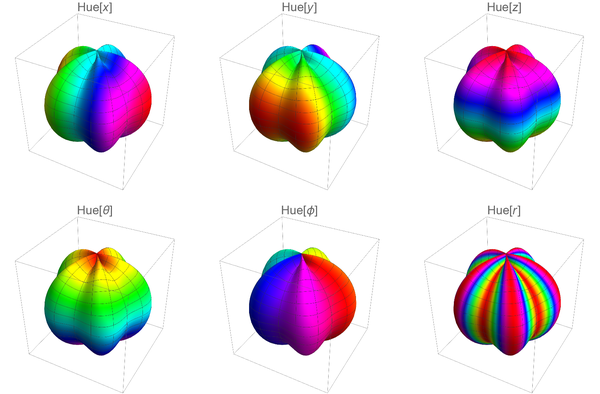The ColorFunction of a SphericalPlot3D has fivesix arguments, the first three being the $x$, $y$ , $z$ coodinates in $\mathbb{R}^3$. The last twofourth and fifth argument are the actual parameterization parameters of the surface and the last argument is the distance from the origin (the radius).
# (Slot) and & (Function) together allow to define anonymous function. #4 and #5 refer to the fourth and fifth argument. Here is (essentially) equivalent rewrite with Function in long form:
SphericalPlot3D[1, {θ, 0, π}, {ϕ, 0, 2 π},
ColorFunction ->
Function[
{x, y, z, u, v},
ColorData["Rainbow"][Re[SphericalHarmonicY[5, 2, u, v]]]
],
ColorFunctionScaling -> False
]
Compare this also toHere is the followingexample from the documentation:
gGraphicsGrid[
=Partition[#, GraphicsRow[3] &@
Table[SphericalPlot3D[
Table[
SphericalPlot3D[1 1 + Sin[5 ϕ]/10, {θ, 0, πPi}, {ϕ, 0, 2 πPi},
PlotPoints -> 100,
ColorFunction -> f
],
{f,
{
Function[{x, y, z, u, v}, ColorData["Rainbow"][(1 + Sin[5 Pi x])/2]],
Function[{x, y, zθ, uϕ, vr}, ColorData["Rainbow"][(1 + Sin[5 Pi y])/2]]Evaluate[f]],
Function[{x,PlotLabel y,-> zf, u,
v}, ColorData["Rainbow"][(1 + Sin[5Axes Pi-> z])/2]]None],
Function[{xf, y{Hue[x], zHue[y], uHue[z], v}Hue[θ], ColorData["Rainbow"][(1 + Sin[5 Pi u])/2]],
Function[{x, y, z, u, v}Hue[ϕ], ColorData["Rainbow"][(1 + Sin[5 Pi v])/2]]
Hue[r]}
}
],
ImageSize -> Full
]


